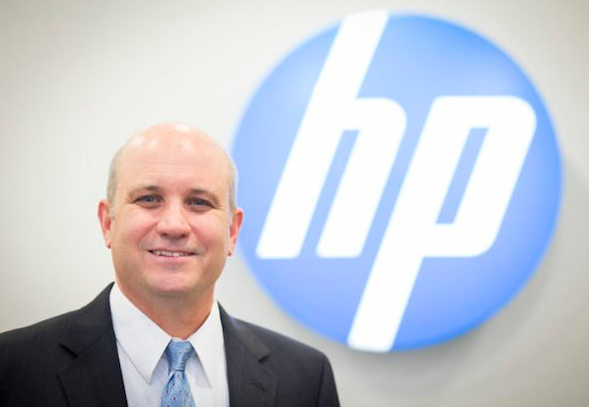
In 2015, Hewlett-Packard split into two companies: Hewlett Packard Enterprise, focused on enterprise products and services, and HP Inc, focused on PCs, copiers, and 3D printers. Despite the split happening nearly three years ago, George Brasher, managing director of HP Inc for the UK and Ireland, says his first question for journalists is always whether they know about the division.
“Coming up at the end of this month it’ll be the end of our third year as a standalone company,” he told Computer Business Review at HP Inc’s London offices.
“For us it’s been great and we’ve had a very consistent and stable strategy.”
The Texas-native has spent 28 years with HP, having started fresh out of university with the company in the US at the start of the 1990s. Now, having been in London with HP for four years and MD here for nearly three of those, the company is building for the future, with 3D printing a big focus.
“Our CEO is from Australia, he’s a surfer, and he said he thinks of it in waves, so core, growth and future. The future is really about what we call blended reality; how do you move from the physical to the digital and back again, and really how do you express it. And that’s around 3D printing.”
3D Printing: HP “Bringing Metal Production Online”
Just last month, HP unveiled the Metal Jet 3D printer for corporations, bringing mass production of metals online. Plastics and metal are the two big substrates in 3D printing, he told Computer Business Review, and while the Multi Jet Fusion covered the former, with the Metal Jet the company’s is “bringing metal production online”. 
While the 3D-printing industry is still up and coming, Brasher refutes the suggestion that the industry is still at a niche stage; particularly when you take into account HP’s 3D printing clients – which include Nike, BMW, and aerospace manufacturer GKM.
“We have customers that we sell PCs or printing to, the largest manufacturers in the UK, and 3D printing is at the top of their agenda,” he said. “It’s kind of this dichotomy – the industry is still growing, it’s still starting up. On the other hand, the market, the best estimates we see are around $30 billion – that’s a big business.”
Brasher said that with HP’s current printers on the market, the break even point is around 55,000 parts. Any product that would require over 55,000 parts to be printed would be more economically produced using traditional manufacturing processes. Therefore, the company wants to continue to ramp that number up going forward.
“If you think about linear production lines, most of them are set up outside of the country they’re consumed, they’re based on manufacturing methodologies that have been around for 100 years.
“With 3D printing, you can create very customised products, you can do it at the point of consumption, so you can reduce costs and the negative impact on the environment from transportation or waste.”
The company will begin shipping the Metal Jet in 2020 to early customers, with broad availability in 2021. They will retail at under $399,000. Meanwhile from 2019 customers will be able to upload 3D design files and receive industrial-grade parts in large quantities from the new Metal Jet Production Service.
Read this: HP Sees Margin Opportunity in Services, Continues 3D Printing Push
Earlier this year, HP completed the purchase of Samsung’s printer business for just over $1 billion. The HP MD said the purchase brought HP thousands of patents, engineers, a boost in the A3, and software as well as hardware assets – something increasingly important as the printer evolves.
“What Samsung gave us was the ability to purchase that base printing technology, not just hardware, but all the solution architecture that came around that.
“It’s really about a connected device that sits on the network, it’s got to print great, but it’s also got to have security that sits around it and it’s got to have a level of solutions so it integrates with business processes.
“There’s no longer this standalone copier that sits in the corner that’s kind of on its own, it’s a network device, so we decided to have both the hardware and software assets.”
HP’s gaming line-up has also now “come into its own”, Brasher said, and the company will continue to push innovation in gaming as the industry gets bigger and more popular. The MD knows this from first-hand experience, based on the advice he gets from his gamer sons, one of whom has a Spectre laptop, and the other an Omen.
“I have teenage boys so I know, gaming’s incredibly popular whether it’s console-based or PC-based. We have a new air-cooled headset – my son said, “this is really important dad; you need to have that in your line-up.”
After four years in the UK, Brasher told Computer Business Review that he and his family are now integrated with the British way of life, from travelling on the tube to regular roast dinners, and rambles in the country.
Football — the British version, not the American version — is also a big part of his time outside of HP, and the keen Chelsea fan takes regular trips to Stamford Bridge with his younger son to watch his team play.
“I like HP and I like the opportunities but I really like London. Anything you like to do London has, if you like movies, great, you’ve got movie premieres, you’ve got movie festivals. You’ve got the best museums in the world. Music – you can get any kind of live music you want. So I think it’s just a great city for living.
“The Sunday roast is something we’ve really learned to love as a family. The Yorkshires you want piping hot as they come out the oven.”






